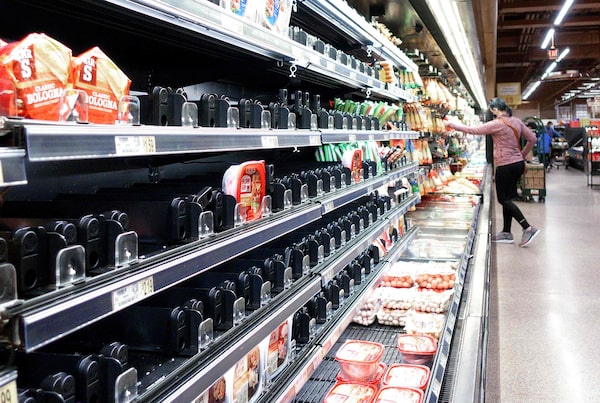
Shelves that held ham products are partially empty at a grocery in Fairfax Virginia, on Jan. 13, 2022.OLIVIER DOULIERY/AFP/Getty Images
Gus Carlson is a New York-based columnist for The Globe and Mail
The scenes in U.S. grocery stores this week were a haunting déjà vu: agitated shoppers squabbling over the last packages of ground chuck, parents searching frantically for baby food, pet lovers coming up empty in their quest for kibble and kitty chow, and store managers doling out packages of toilet paper as if they were as valuable as gold bars – or COVID-19 test kits.
In supermarkets and big-name superstores from New York to Los Angeles, and many cities in between, the empty shelves reflecting widespread shortages of food and household products harken back to the early days of the pandemic, when lockdowns drove people to hoard supplies, not knowing what to expect or for how long.
Those were some ugly days of panic buying, when shouting matches erupted in stores over the rationing of paper towels and other staples, and price gouging on everything from disinfectant wipes to hand sanitizer was the norm. And who, other than health care professionals or scientists, had even heard of an N95 mask before then, let alone would want to buy a gross of them?
While the pandemic remains a factor in the current consumer pinch, it is a more complicated situation than it was two years ago and, therefore, more difficult to resolve.
Consumers are now caught in a perfect storm of problems that begins globally, but swirls into national and eventually local crises. The list of contributing factors gets longer every day.
Supply-chain snafus are choking off incoming goods – and in many cases, the materials needed to make goods. Continuing backups at major seaports and a crippling shortage of truck drivers are slowing the shipment of goods.
Widespread labour shortages, exacerbated by Omicron sick days and juicy government stimulus packages that make collecting unemployment benefits more profitable than working, are leaving store chains short of staff to unload trucks, stock shelves and work registers.
And runaway inflation, which reached a three-decade high of 7 per cent in the U.S. last year, has made everything, including the fuel used to transport goods, more expensive.
Add to these transportation delays owing to recent severe winter in the U.S. Northeast and mid-Atlantic, and the situation has gone from bad to worse.
Putting even more pressure on the system is a behavioural change driven by pandemic-related lockdowns and work-at-home habits: People are cooking and eating at home more often, which means greater demand for groceries and household supplies.
The result: Major grocery store chains have seen a marked increase in the scarcity of products they sell, even everyday items such as paper towels and toilet paper, foods including meat and fresh produce – and even beer. Industry experts say that, typically, most grocery stores expect to be short 5 per cent to 10 per cent of their inventory at any given time. But that has risen to about 15 per cent now.
The empty shelves and scarcity of goods are more than annoying. People are worried. A new KPMG study says 71 per cent of respondents were somewhat or very concerned about the shortages.
As a result, shoppers are turning to online channels to find products they can’t get in stores. Topping their lists: meat, lettuce, eggs, chicken, potatoes, pasta, spinach, eggs, pet food and, curiously, cream cheese. Baby formula and baby food are also in high demand and short supply.
The pressing question now is how to fix it. Last year, U.S. President Joe Biden took steps to increase the operating hours of major ports such as Los Angeles and Long Beach. Other ports, including some on the U.S. East Coast, expanded operations in an effort to ease the crunch.
Several big companies hired their own ships to sidestep the port backlog. And in October, Mr. Biden floated the idea of enlisting members of the National Guard to step up as truck drivers, though that concept has yet to take shape.
Store chains, too, are looking for solutions. Many have launched nationwide campaigns to recruit and train truck drivers. Some are employing new ways of managing inventory, including rotating product selection from day to day to make supplies last longer and, in some cases, limiting quantities on a per-customer basis.
The rest of the solution may lie with consumers themselves: deciding what they can live without until the situation stabilizes. In a culture of plenty, where consumers expect to get anything and everything all the time – and can get downright nasty when they don’t – that may be easier said than done.
Of course, our babies and pets all need to eat, and we need keep our houses clean, especially as the fight against COVID variants continues. But there are some things that are clearly nice-to-haves, not necessities.
Who doesn’t like a schmear of cream cheese on a bagel from time to time? But if we have to forgo that luxury for a while, it won’t kill us. In fact, it might be good for us. It certainly isn’t worth fighting about.
Your time is valuable. Have the Top Business Headlines newsletter conveniently delivered to your inbox in the morning or evening. Sign up today.